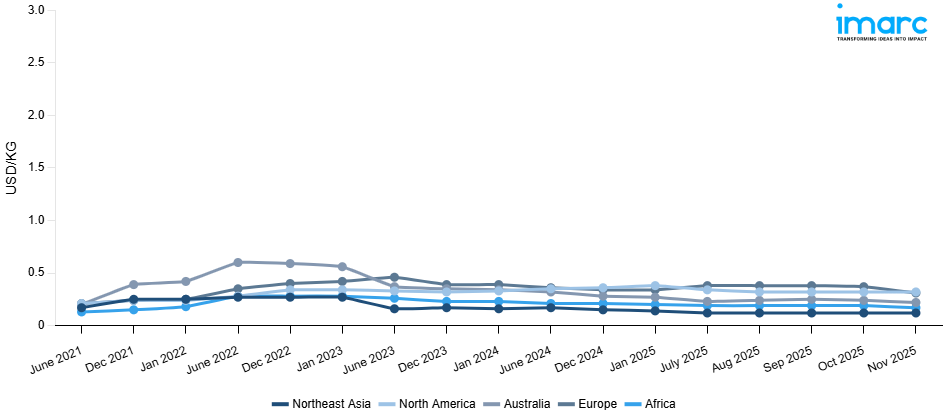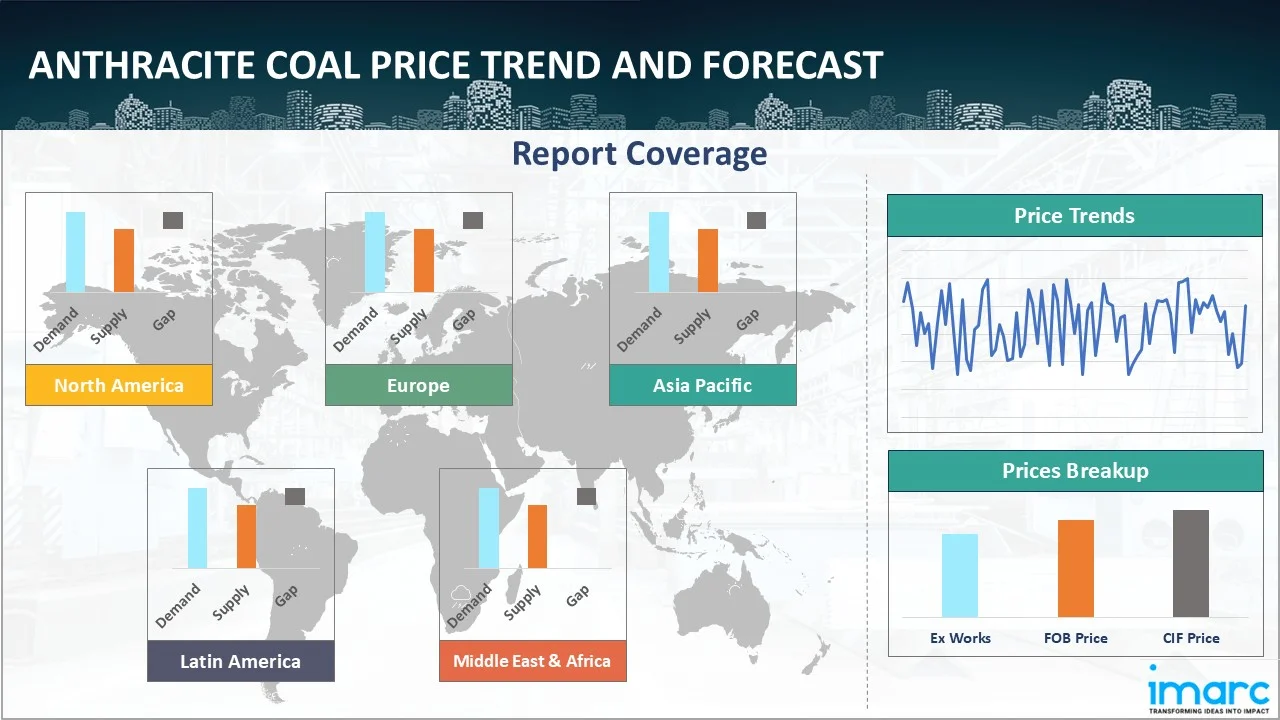
Anthracite Coal Prices, Trend, Chart, Demand, Market Analysis, News, Historical and Forecast Data Report 2025 Edition
Anthracite Coal Price Trend, Index and Forecast
Track real-time and historical anthracite coal prices across global regions. Updated monthly with market insights, drivers, and forecasts.
Anthracite Coal Prices November 2025
| Region | Price (USD/KG) | Latest Movement |
|---|---|---|
| Africa | 0.17 | -11.4% ↓ Down |
| Northeast Asia | 0.12 | 1.4% ↑ Up |
| Europe | 0.31 | -16.3% ↓ Down |
| Australia | 0.22 | -7.8% ↓ Down |
| North America | 0.32 | 0.6% ↑ Up |
Anthracite Coal Price Index (USD/KG):
The chart below highlights monthly anthracite coal prices across different regions.

Get Access to Monthly/Quaterly/Yearly Prices, Request Sample
Market Overview Q3 Ending September 2025
Africa: In Africa, anthracite coal prices edged slightly lower as stable mining output maintained a steady flow of supply. The anthracite coal price index reflected muted procurement, with limited demand from the power generation and industrial sectors. Ample availability prevented any major price movements, while subdued export interest added to the overall soft sentiment. Although operational costs remained steady, buyers maintained a cautious stance, contributing to the marginal decline in regional prices this quarter.
Northeast Asia: In Northeast Asia, anthracite coal prices increased moderately, supported by stronger industrial demand and higher offtake from the steel sector. The anthracite coal price index highlighted improved procurement activity, with steady power sector consumption also reinforcing market strength. Supply chain constraints in select ports provided additional upward momentum. Despite global bearish sentiment, regional consumption trends and stable production levels sustained positive pricing movement in the market this quarter.
Europe: In Europe, anthracite coal prices slipped slightly due to muted industrial demand and ongoing transitions toward alternative energy sources. The anthracite coal price index showed weaker buying activity, with excess inventories weighing on the market. Energy cost dynamics further influenced procurement, while subdued demand from steelmaking and heavy industries curbed market momentum. Despite this, stable mining operations ensured sufficient supply, keeping price declines relatively limited across the region.
Australia: In Australia, anthracite coal prices rose as consistent demand from domestic steel and energy sectors supported procurement. The anthracite coal price index reflected stronger consumption levels, with steady exports to Asia adding further support. Robust supply chain operations ensured stable availability, but higher industrial activity created upward pressure on pricing. This trend contrasted global bearishness, marking Australia as one of the more resilient markets this quarter.
North America: In North America, anthracite coal prices inched upward, supported by stable demand from the power generation and industrial heating sectors. The anthracite coal price index showed steady procurement activity, aided by resilient consumption in construction-related industries. Abundant mining output ensured balanced supply, preventing sharper price gains. While demand fundamentals remained consistent, competitive market conditions kept increases moderate this quarter.
Anthracite Coal Price Trend, Market Analysis, and News
IMARC's latest publication, “Anthracite Coal Prices, Trend, Chart, Demand, Market Analysis, News, Historical and Forecast Data Report 2025 Edition,” presents a detailed examination of the anthracite coal market, providing insights into both global and regional trends that are shaping prices. This report delves into the spot price of anthracite coal at major ports and analyzes the composition of prices, including FOB and CIF terms. It also presents detailed anthracite coal prices trend analysis by region, covering North America, Europe, Asia Pacific, Latin America, and Middle East and Africa. The factors affecting anthracite coal pricing, such as the dynamics of supply and demand, geopolitical influences, and sector-specific developments, are thoroughly explored. This comprehensive report helps stakeholders stay informed with the latest market news, regulatory updates, and technological progress, facilitating informed strategic decision-making and forecasting.

Anthracite Coal Industry Analysis
The global anthracite coal industry size reached 914.47 Million Tons in 2025. By 2034, IMARC Group expects the market to reach 1,102.56 Million Tons, at a projected CAGR of 2.10% during 2026-2034. The market is driven by fluctuating steel industry demand, global energy transition policies, mining and logistics costs, environmental regulations, currency volatility, and competition from alternative fuels such as natural gas and renewables shaping long-term consumption trends.
Latest developments in the Anthracite Coal Industry:
- May 2025: Menar finalized the purchase of the Springlake Colliery anthracite mine from Mylotex (Pty) Ltd, which was undergoing business rescue proceedings. Strategically, the deal strengthened Menar’s ability to supply both domestic industries and export markets that rely on ultra-high-grade anthracite.
- June 2024: One of the prominent producers of UHG anthracite producer in the United States, Atlantic Carbon Group, Inc. (ACG), was acquired by PT Delta Dunia Makmur Tbk through American Anthracite SPV I, LLC, a subsidiary of PT Bukit Makmur Internasional (BUMA International), through a stock purchase agreement (SPA).
Product Description
Anthracite coal is the highest grade of coal, distinguished by its hard, dense structure, metallic luster, and high carbon content, typically ranging between 86–97%. Formed under intense heat and pressure during metamorphism, it burns hotter and cleaner than other coal types, producing minimal smoke and low volatile emissions. This makes anthracite a preferred fuel for residential heating, industrial furnaces, and metallurgical processes where consistent, high-temperature combustion is required. Its superior energy content and low impurities also make it valuable in steelmaking, ferroalloy production, and water filtration systems.
Report Coverage
| Key Attributes | Details |
|---|---|
| Product Name | Anthracite Coal |
| Report Features | Exploration of Historical Trends and Market Outlook, Industry Demand, Industry Supply, Gap Analysis, Challenges, Ammonia Price Analysis, and Segment-Wise Assessment. |
| Currency/Units | US$ (Data can also be provided in local currency) or Metric Tons |
| Region/Countries Covered | The current coverage includes analysis at the global and regional levels only. Based on your requirements, we can also customize the report and provide specific information for the following countries: Asia Pacific: China, India, Indonesia, Pakistan, Bangladesh, Japan, Philippines, Vietnam, Thailand, South Korea, Malaysia, Nepal, Taiwan, Sri Lanka, Hongkong, Singapore, Australia, and New Zealand* Europe: Germany, France, United Kingdom, Italy, Spain, Russia, Turkey, Netherlands, Poland, Sweden, Belgium, Austria, Ireland, Switzerland, Norway, Denmark, Romania, Finland, Czech Republic, Portugal and Greece* North America: United States and Canada Middle East & Africa: Saudi Arabia, UAE, Israel, Iran, South Africa, Nigeria, Oman, Kuwait, Qatar, Iraq, Egypt, Algeria, and Morocco* Latin America: Brazil, Mexico, Argentina, Columbia, Chile, Ecuador, Peru* *The list of countries presented is not exhaustive. Information on additional countries can be provided if required by the client. |
| Information Covered for Key Suppliers |
|
| Customization Scope | The report can be customized as per the requirements of the customer |
| Report Price and Purchase Option |
Plan A: Monthly Updates - Annual Subscription
Plan B: Quarterly Updates - Annual Subscription
Plan C: Biannually Updates - Annual Subscription
|
| Post-Sale Analyst Support | 360-degree analyst support after report delivery |
| Delivery Format | PDF and Excel through email (We can also provide the editable version of the report in PPT/Word format on special request) |
Key Benefits for Stakeholders:
- IMARC’s report presents a detailed analysis of anthracite coal pricing, covering global and regional trends, spot prices at key ports, and a breakdown of FOB and CIF prices.
- The study examines factors affecting anthracite coal price trend, including input costs, supply-demand shifts, and geopolitical impacts, offering insights for informed decision-making.
- The competitive landscape review equips stakeholders with crucial insights into the latest market news, regulatory changes, and technological advancements, ensuring a well-rounded, strategic overview for forecasting and planning.
- IMARC offers various subscription options, including monthly, quarterly, and biannual updates, allowing clients to stay informed with the latest market trends, ongoing developments, and comprehensive market insights. The anthracite coal price charts ensure our clients remain at the forefront of the industry.
Key Questions Answered in This Report
The anthracite coal prices in November 2025 were 0.17 USD/Kg in Africa, 0.12 USD/Kg in Northeast Asia, 0.31 USD/Kg in Europe, 0.22 USD/Kg in Australia, and 0.32 USD/Kg in North America.
The anthracite coal pricing data is updated on a monthly basis.
We provide the pricing data primarily in the form of an Excel sheet and a PDF.
Yes, our report includes a forecast for anthracite coal prices.
The regions covered include North America, Europe, Asia Pacific, Middle East, and Latin America. Countries can be customized based on the request (additional charges may be applicable).
Yes, we provide both FOB and CIF prices in our report.
Need more help?
- Speak to our experienced analysts for insights on the current market scenarios.
- Include additional segments and countries to customize the report as per your requirement.
- Gain an unparalleled competitive advantage in your domain by understanding how to utilize the report and positively impacting your operations and revenue.
- For further assistance, please connect with our analysts.
Why Choose Us
IMARC offers trustworthy, data-centric insights into commodity pricing and evolving market trends, enabling businesses to make well-informed decisions in areas such as procurement, strategic planning, and investments. With in-depth knowledge spanning more than 1000 commodities and a vast global presence in over 150 countries, we provide tailored, actionable intelligence designed to meet the specific needs of diverse industries and markets.
1000
+Commodities
150
+Countries Covered
3000
+Clients
20
+Industry
Robust Methodologies & Extensive Resources
IMARC delivers precise commodity pricing insights using proven methodologies and a wealth of data to support strategic decision-making.
Subscription-Based Databases
Our extensive databases provide detailed commodity pricing, import-export trade statistics, and shipment-level tracking for comprehensive market analysis.
Primary Research-Driven Insights
Through direct supplier surveys and expert interviews, we gather real-time market data to enhance pricing accuracy and trend forecasting.
Extensive Secondary Research
We analyze industry reports, trade publications, and market studies to offer tailored intelligence and actionable commodity market insights.
Trusted by 3000+ industry leaders worldwide to drive data-backed decisions. From global manufacturers to government agencies, our clients rely on us for accurate pricing, deep market intelligence, and forward-looking insights.
 Request Customization
Request Customization
 Inquire Before Buying
Inquire Before Buying
 Speak to an Analyst
Speak to an Analyst Request Brochure
Request Brochure




.webp)




.webp)












